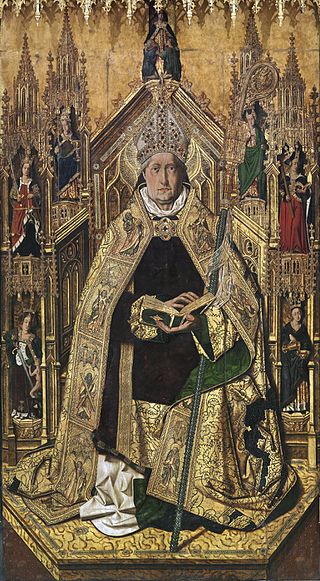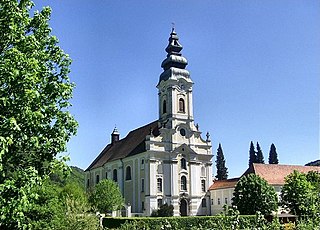
Abbot is an ecclesiastical title given to the head of an independent monastery for men in various Western Christian traditions. The name is derived from abba, the Aramaic form of the Hebrew ab, and means "father". The female equivalent is abbess.

The Trappists, officially known as the Order of Cistercians of the Strict Observance and originally named the Order of Reformed Cistercians of Our Lady of La Trappe, are a Catholic religious order of cloistered monastics that branched off from the Cistercians. They follow the Rule of Saint Benedict and have communities of both monks and nuns that are known as Trappists and Trappistines, respectively. They are named after La Trappe Abbey, the monastery from which the movement and religious order originated. The movement began with the reforms that Abbot Armand Jean le Bouthillier de Rancé introduced in 1664, later leading to the creation of Trappist congregations, and eventually the formal constitution as a separate religious order in 1892.

The Missionary Oblates of Mary Immaculate (OMI) is a missionary religious congregation in the Catholic Church. It was founded on January 25, 1816, by Eugène de Mazenod, a French priest later recognized as a Catholic saint. The congregation was given recognition by Pope Leo XII on February 17, 1826. As of January 2020, the congregation was composed of 3,631 priests and lay brothers usually living in community. Their traditional salutation is Laudetur Iesus Christus, to which the response is Et Maria Immaculata. Members use the post-nominal letters, "OMI".

The Catholic Church in South Africa is part of the worldwide Catholic Church composed of the Latin Church and 23 Eastern Catholic Churches, of which the South African church is under the spiritual leadership of the Southern African Catholic Bishops Conference and the pope in Rome. It is made up of 26 dioceses and archdioceses plus an apostolic vicariate.

Casamari Abbey is a Cistercian abbey in the Province of Frosinone, Lazio, Italy, about 10 kilometers east-south-east of Veroli.
The Vicariate Apostolic of Natal was a Roman Catholic missionary, quasi-diocesan jurisdiction in South Africa.

Tre Fontane Abbey, or the Abbey of Saints Vincent and Anastasius, is a Roman Catholic abbey in Rome, held by monks of the Cistercian Order of the Strict Observance, better known as Trappists. It is known for raising the lambs whose wool is used to weave the pallia of new metropolitan archbishops. The pope blesses the lambs on the feast of Saint Agnes on January 21. The wool is prepared, and he gives the pallia to the new archbishops on the Solemnity of Saints Peter and Paul, the Holy Apostles.
Mariannhill is a cluster of suburbs and townships in eThekwini Municipality in KwaZulu Natal, South Africa.
The Roman Catholic Diocese of Mariannhill is a diocese located in the city of Mariannhill in the ecclesiastical province of Durban in South Africa.

Engelszell Abbey was the last Trappist monastery in Austria. It is located near Engelhartszell an der Donau in the Innviertel in Upper Austria.

Franz Pfanner, CMM, also anglicised as Francis Pfanner, was an Austrian Catholic monk and founder of what would become the Mariannhillers. He was a member of the Trappists, from whom the new order was branched off.

Frigolet Abbey is a grand Premonstratensian monastery complex in Southern France. It is located in the territorial commune of Tarascon, in the region of the Montagnette, the parishes of which are served by the canons of the monastery. It was originally associated with the Order of Saint Benedict.
The Subiaco Cassinese Congregation is an international union of Benedictine houses within the Benedictine Confederation. It developed from the Subiaco Congregation, which was formed in 1867 through the initiative of Dom Pietro Casaretto, O.S.B., as a reform of the way of life of monasteries of the Cassinese Congregation, formed in 1408, toward a stricter contemplative observance, and received final approval in 1872 by Pope Pius IX. After discussions between the two congregations at the start of the 21st century, approval was given by Pope Benedict XVI in 2013 for the incorporation of the Cassinese Congregation into its offshoot, the Subiaco Congregation. The expanded congregation was given this new name.

Armand Jean le Bouthillier de Rancé was a French abbot of La Trappe Abbey, a controversialist author, and a founding father of the Trappists.

Silverstream Priory is a Roman Catholic monastery in Stamullen, County Meath, Ireland, founded in 2012. The monastery is an autonomous diocesan priory of the Benedictine Monks of Perpetual Adoration.

Mariastern Abbey is a Trappist abbey in Bosnia and Herzegovina, situated near the country's second largest city Banja Luka. It consists of the Church of the Assumption of the Blessed Virgin Mary and the monastery of Trappist monks. It is the only Trappist monastery in Southeastern Europe. At the beginning of the 20th century, with 219 monks, the Abbey was the largest Trappist abbey in the world; today it is the smallest, with only two monks.

Engelmar Unzeitig, born Hubert Unzeitig, was a German Roman Catholic priest who died in the Dachau Concentration Camp during World War II on the charge of being a priest. He was a professed member of the Missionary Order of Mariannhill and assumed the religious name Engelmar when he was admitted into the order. He became known as the "Angel of Dachau".

St. Patrick's Cathedral, also known simply as Kokstad Cathedral, is a parish of the Roman Catholic Church in Kokstad, KwaZulu-Natal, South Africa and the cathedral of the Diocese of Kokstad. The cathedral church is located at 107 Hope Street.
Siegfried Mandla Jwara, CMM is a South African Catholic prelate who has served as Archbishop of Durban since 2021. He was previously Apostolic Vicar of Ingwavuma beginning in 2016. He is a member of the Mariannhillers.
Thulani Victor Mbuyisa is a South African Roman Catholic priest who was appointed as Bishop of the Roman Catholic Diocese of Kokstad, in South Africa, on 6 April 2022.














